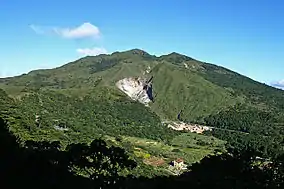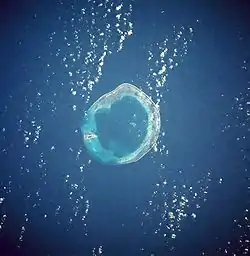National parks of Taiwan
National parks of Taiwan are protected spaces for their nature, wildlife, and history in its current jurisdiction. Currently there are nine national parks in Taiwan, all are under the administration of the Ministry of the Interior. These national parks covers 7,489.49 square kilometres (2,891.71 sq mi).[1] The 3,103.76-square-kilometre (1,198.37 sq mi) total land area constitutes around 8.6% of the entire land area of the country.

The first national parks were established in 1937, when Taiwan was under Japanese rule. After World War II, the voice for protecting the natural environment was suspended due to the autocratic rule and the Martial law in Taiwan. The National Park Law was passed in 1972 and finally the first new national parks were reestablished in 1984.[2]
National parks should not be confused with national scenic areas. The national scenic areas are administrated by the Tourism Bureau of the Ministry of Transportation and Communications.[3] There are also different philosophies that govern the development of the two types of areas. For a national park, the emphasis is on the preservation of natural and cultural resources, and development for human utilization is definitely a secondary priority.[3]
History
The first national parks (國立公園, Kokuritsu Kōen) in Taiwan were appointed in December 27, 1937 by Governor-General Seizō Kobayashi (小林躋造). This was when Taiwan was under Japanese rule, thus these three national parks are designated to be the national parks of the Empire of Japan.
| Name | Japanese | Taiwanese | Today's equivalent |
|---|---|---|---|
| Daiton National Park | 大屯國立公園 | Toā-tūn Kok-li̍p Kong-hn̂g | Yangmingshan National Park |
| Nītaka-Arisan National Park | 新高阿里山國立公園 | Sin-ko A-lí-san Kok-li̍p Kong-hn̂g | Yushan National Park and Alishan National Scenic Area |
| Tsugitaka-Taroko National Park | 次高タロコ國立公園 | Chhù-ko Thài-ló͘-koh Kok-li̍p Kong-hn̂g | Taroko National Park and Shei-Pa National Park |
The administration of these national parks was no longer in force when Japan withdrew from Taiwan in 1945 after World War II. There were no national parks in Taiwan since then until the new national parks law in the 1980s. The first new established national parks at that time were on similar places to the Japanese establishments.
Current national parks of Taiwan
Currently there are nine national parks in Taiwan. There is also one national nature park, which is designed for areas with fewer resources compare to a full national park.
| Name | Chinese | Taiwanese | Hakka | Date established | Area | Description | Image |
|---|---|---|---|---|---|---|---|
| Kenting National Park | 墾丁國家公園 | Khún-teng Kok-ka Kong-hn̂g | Khén-tên Koet-kâ Kûng-yèn | January 1, 1984 | 332.90 km2 (82,261.4 acres), 180.84 km2 of land, and 152.06 km2 water | Located on the southern tip of Taiwan, it is also the oldest national park on the Taiwan (Pingtung County), Kenting is famous for its tropical coral reef and migratory birds. |  |
| Yushan National Park | 玉山國家公園 | Gio̍k-san Kok-ka Kong-hn̂g | Ngiu̍k-sân Koet-kâ Kûng-yèn | April 6, 1985 | 1,031.21 km2 (254,817.5 acres) | The largest national park in Taiwan, located on the central part of the island. It is named after Mount Jade (Yushan literally means "Jade Mountain") which is the highest peak in East Asia at 3,952 metres. |  |
| Yangmingshan National Park | 陽明山國家公園 | Iûⁿ-bêng-soaⁿ Kok-ka Kong-hn̂g | Yòng-mìn-sân Koet-kâ Kûng-yèn | September 16, 1985 | 113.38 km2 (28,016.8 acres) | The northernmost national park on the island of Taiwan; it has a volcanic landform. Yangminshan is famous for its hotsprings and geothermal phenomenon. Each spring, Yangminshan also have a dazzling flower season. It is located partially in Taipei City and partially in New Taipei City. |  |
| Taroko National Park | 太魯閣國家公園 | Thài-ló͘-koh Kok-ka Kong-hn̂g | Thai-lû-kok Koet-kâ Kûng-yèn | November 28, 1986 | 920 km2 (227,337.0 acres) | A magnificent marble gorge cut by Li-Wu River, creating one of the most astounding landscape in the world. It is also the home of the indigenous Truku people. Taroko is located in eastern Taiwan. |  |
| Shei-Pa National Park | 雪霸國家公園 | Soat-pà Kok-ka Kong-hn̂g | Siet-pa Koet-kâ Kûng-yèn | July 1, 1992 | 768.5 km2 (189,900.5 acres) | Located in the central northern part of Taiwan island, in Hsinchu County and Miaoli County. It encompasses Xueshan (Snow Mountain), the second tallest mountain in Taiwan and East Asia, and Dabajian Mountain. |  |
| Kinmen National Park | 金門國家公園 | Kim-mn̂g Kok-ka Kong-hn̂g | Kîm-mùn Koet-kâ Kûng-yèn | October 18, 1995 | 35.29 km2 (8,720.3 acres) | Located on an island just off the coast of Mainland China, it includes famous historical battlefields in Kinmen. It is also known for its wetland ecosystem and traditional Fujian buildings that dated back to the Ming Dynasty. |  |
| Dongsha Atoll National Park | 東沙環礁國家公園 | Tang-soa Khoân-ta Kok-ka Kong-hn̂g | Tûng-sâ Fàn-chiâu Koet-kâ Kûng-yèn | October 4, 2007 | 3,536.68 km2 (873,932.7 acres), including 1.79 km2 of land | Taiwan's first marine national park. The atoll and the adjacent waters provide for a rich biodiversity of marine life from fish, jelly fish, squid, sicklefin lemon sharks, and rays to sea turtles, Dugongs, and cetaceans (dolphins and whales). Because strict protection is being taken, it is currently not open to public tourism. |  |
| Taijiang National Park | 臺江國家公園 | Tâi-kang Kok-ka Kong-hn̂g | Thòi-kông Koet-kâ Kûng-yèn | December 28, 2009 | 393.1 km2 (97,137.1 acres), 49.05 km2 of land, and 344.05 km2 water | Located in southwest Taiwan on the coast of Tainan City. The park's tidal landscape is one of its most distinctive features. Around 200 years ago, a large part of the park was part of the Taijiang Inland Sea. There is a rich variety of marine life, including 205 species of shellfish, 240 species of fish and 49 crab species that thrive on the marshes of southern Taiwan. |  |
| South Penghu Marine National Park | 澎湖南方四島 國家公園 | Phêⁿ-ô͘ Lâm-hong Sù-tó Kok-ka Kong-hn̂g | Phàng-fù Nàm-fông Si-tó Koet-kâ Kûng-yèn |
October 18, 2014 | 358.44 km2 (88,572.5 acres), including 3.70 km2 of land | Located in the south of the Penghu Islands. The seas around the islets feature large clusters of Acropora coral and a diversity of fish and shells living among the reefs. The islets are also known for magnificent basalt terrains and unique low-roofed houses built by early inhabitants with coral stone and basalt.[4] | .jpg.webp) |
National Nature Park
| Name | Chinese | Taiwanese | Hakka | Date established | Area | Image |
|---|---|---|---|---|---|---|
| Shoushan National Nature Park | 壽山國家自然公園 | Siū-san Kok-ka Chū-jiân Kong-hn̂g | Su-sân Koet-kâ Chhṳ-yèn Kûng-yèn | December 6, 2011 | 11.23 km2 (2,775.0 acres) |  |
Proposed national parks
Five other national parks were proposed but the plans of formation were halted due to opposition:
- 馬告檜木國家公園 ("Makauy National Park for Chamaecyparis formosensis", opposed by local indigenous peoples)
- 能丹國家公園("Neng-Dan National Park", opposed by the Bunun people)
- 蘭嶼國家公園 ("Ponso no Tao National Park", opposed by the Tao people)
- 綠島國家公園 ("Green Island National Park", opposed by the inhabitants.)
- 北方三島海洋國家公園 ("Three Northern Islets Marine National Park")
References
- 各國家公園基本資料表 (PDF) (in Chinese). Construction and Planning Agency, Ministry of the Interior, Taiwan. 6 June 2014. Retrieved 21 October 2014.
- Reference on Act Title from Kinmen Park website
- "Taiwan's National Scenic Areas: Balancing Preservation and Recreation". Academia Sinica. 1995-06-01.
- "Beauty of south Penghu islets on display at new national park". Central News Agency. 18 October 2014. Retrieved 21 October 2014.